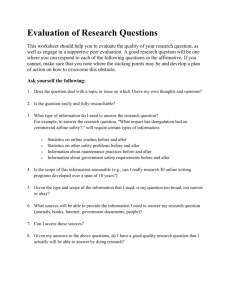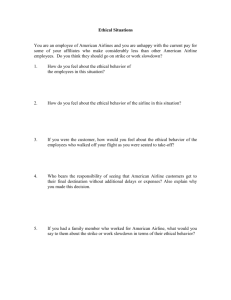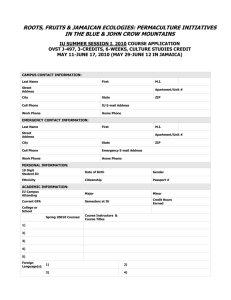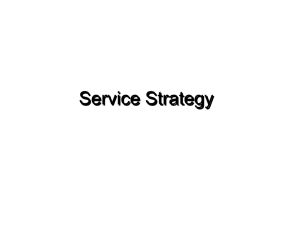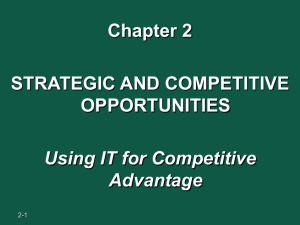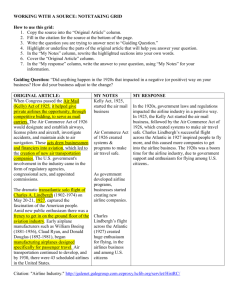Thesis Proposal
advertisement
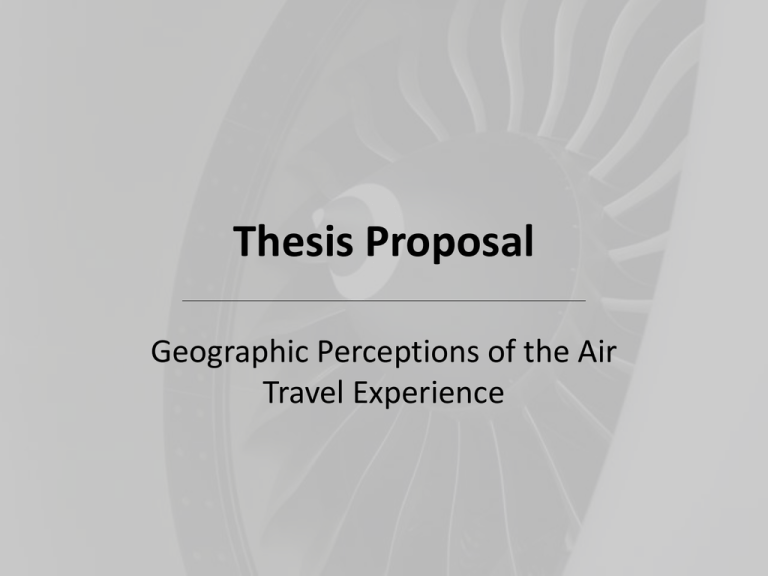
Thesis Proposal Geographic Perceptions of the Air Travel Experience Jonathon Nield Arizona State University Aviation Management & Human Factors Program Overview • • • • • • Introduction Hypothesis Problem Purpose Objectives Literature Review • Literature Review (cont.) • – Introduction • – Safety and Consumer • Demand – Service Quality Pre/Post • 9/11 – Service Quality – Expectations and Perceptions – Conclusion Methodology Participants Questionnaire Sources Introduction • Examine whether a relationship exists between consumer perception of the air travel experience and the competitive makeup of various geographic markets. Hypothesis • There is a direct relationship between the competition of an airline within a geographic market and the consumer’s perceptions of the air travel experience. Problem • Public perception of the airline industry is deteriorating. • Regulatory pressures regarding service quality are increasing. • Airlines are faced with the challenge of competing in markets with heterogeneous demographics and competitors, adding further complexity to managing consumer perceptions. Purpose • Enable airlines, airports, federal agencies, associations, and other entities to dissect consumer perceptions with a precision that allows for corrective action as well as preventative action to weaknesses or threats to public perception. Objectives • Research and examine consumer priorities in their selection of an airline and compare each element against various geographic regions. • Research and assess the applicability of other measures in use such as the Airline Quality Report (AQR) to consumer perceptions. • Study the interactions of various airline experience elements regarding how they affect each other. • Measure the expected level of service and satisfaction of the air travel experience. • Create an index that is a relative measure of consumer satisfaction accounting for the consumer experience from point of purchase to exiting destination airport. • Create a repeatable data collection process to collect diverse data representative of various types of consumers. Literature Review Literature Review: Introduction • Consumer perception of the airline industry’s quality of service has been shown to be declining over the past few decades despite better aircrafts, more services, and more choices. • Airlines are a vital component of U.S. commerce and any declines in the public’s faith and utilization of this industry should be alarming to airline management as well as government officials. • In 2010, U.S. airlines carried 629,517,348 consumers domestically and 88,206,634 consumers to international destinations on a total revenue of over $130.5 Billion (BTS, 2011) Airline Safety & Consumer Demand • Squalli and Saad discovered in their research that there is no statistical evidence of a correlation between consumer perceptions and the number of enplanements (2006). • Accidents with serious injuries has a greater impact on enplanements than accidents with fatalities (Squalli and Saad, 2006). • Following TWA, 85% of frequent consumers believed more money should be spent on safety even if resulting in a higher fare (Cobb and Primo, 2003). Airline Service Quality Pre/Post 9/11 • Cunningham, Young, and Lee conducted a longitudinal study on consumer perceptions of airline service quality as well as risks before and after the 9/11 terrorist attacks. • The final analysis of the research showed that the 9/11 terrorist attacks did have an effect on enplanements. • Overall satisfaction with the airline industry, brand satisfaction, and intention to repatronize the consumers’ brand of choice was not affected. • External shocks to a brand do not affect its positioning with a consumer’s mind. Airline Service Quality • Study done by Tiernan, Rhoades & Waguespack (2008) set out to determine whether a discrepancy exists between reported performance metrics of service quality and consumer perception. • The results of the study showed that airline performance perceptions are worse than secondary metrics provided by the Department of Transportation show. • Former Delta CEO Leo Mullin commented (Thurston, 2000) the airlines suffer from the “challenge of the crowds.” Even if performance indicators lead over 90%99%, those thousands with the negative experience may become the perceptions of the majority. Expectation and Perceptions Researchers Airline Service Quality Elements Gourdin (1988) Price, safety, and timelines Elliott and Roach (1993) Timeliness, luggage transport, food and beverage quality, seat comfort, the check in process, and in-flight service dimensions Ostrowski et al. (1993) Timeliness, food and beverage quality, and comfort of seat dimensions Truitt and Haynes (1994) Check-in process, the convenience of transit, the processing of luggage, timeliness, seat cleanliness, food and beverage quality, and handling of customer complaints Bowen and Headley (2000) On-time arrival, mishandled baggage, being denied boardings, and airline safety Pakdil & Aydin, 2007 Consumer complaints on items such as flight, reservation, ticketing and boarding problems, fares, refunds, customer service, advertising, and frequent flyer programs Literature Review: Conclusion • A gap in research that addresses the variations of the perceived level of service on the basis of geographic markets. The influence that geographic markets have on the perception of the air travel experience will be addressed in this study. Methodology • Use of multiple regression analysis to establish whether the variables in differing geographic markets impact the perceptions of consumers. • Identify the specific elements of the air travel experience that vary within geographic markets. • Participants complete a Likert questionnaire to measure the perceived level of service during their recent air travel and compare those results against the expected level of service in each geographic market. Participants • Participation will be solicited from airports, frequent flyer organizations, corporations, and the general public through the use of various web and social media channels as well as traditional paper and pencil use. • Participating airports: Dallas-Fort Worth International, Phoenix Sky Harbor International, Denver International, and Jackson Hartfield International Participants • The questionnaire will include questions relating to the subject’s demographics and travel patterns including: – – – – – – – – Gender Age Zip code Income Leisure/Business/Both flyer Frequency of flying Most traveled destinations Frequent flyer memberships Questionnaire • The questionnaire will be divided into 5 parts: – Airport Arrival – Ticketing/Check In – Security – Lounge – Inflight – Airport Departure Sources • • • • • • • • • • • Squalli, J., & Saad, M. (2006). Accidents, Airline Safety Perceptions and Demand. Journal of Economics and Finance, 30(Fall), 297-305. Retrieved from http://search.proquest.com Cobb, R. W. and Primo, D. M. (2003). The Plane Truth: Airline Crashes, the Media, and Transportation Policy. Washington, DC: Brookings Institution Press. Lee, M., Young, C., Cunningham, L., & Wadsworth, L. (2002). Perceptions of airline service quality: Pre and Post 9/11, Public Works Management Policy. Retrieved from http://pwm.sagepub.com Tiernan, S., Rhoades, D., & Waguespack, B. (2008). Airline service quality: Exploratory analysis of consumer perceptions and operational performance in the USA and EU. Vol. 18(3), 212-224. Emerald Group Publishing, Limited. Thurston, S. (2000), Delta: Mullin's Mark Q&A: ‘We fight to boost service.’ Atlanta Journal- Constitutiona, Vol. 16, April, p. H8. Gourdin, K. (1988). Bringing quality back to commercial travel. Transportation Journal 27, 23–29. Retrieved from http://web.ebscohost.com Elliott, K.M., and Roach, D.W. (1993). Service quality in the airline industry: are carrier getting an unbiased evaluation from consumers? Journal of Professional Services Marketing 9, 71–82. Ostrowski, P.L., O’Brien, T.V., and Gordon, G.L. (1993). Service quality and customer loyalty in the commercial airline industry. Journal of Travel Research, 32, 16–24. Retrieved from http://jtr.sagepub.com Truitt, L.J. and Haynes, R. (1994). Evaluating service quality and productivity in the regional airline industry. Transportation Journal 33, 21–32. Bowen, B.D. & Headley, D.E. (2010). Airline Quality Rating Report 2010. Wichita, KS: W. Frank Barton School of Business. Retrieved from www.aqr.aero. Pakdil, F. and Aydın, O. (2007). Expectations and perceptions in airline services: An analysis using weighted SERVQUAL scores. Journal of Air Transport Management 13, 229–237
